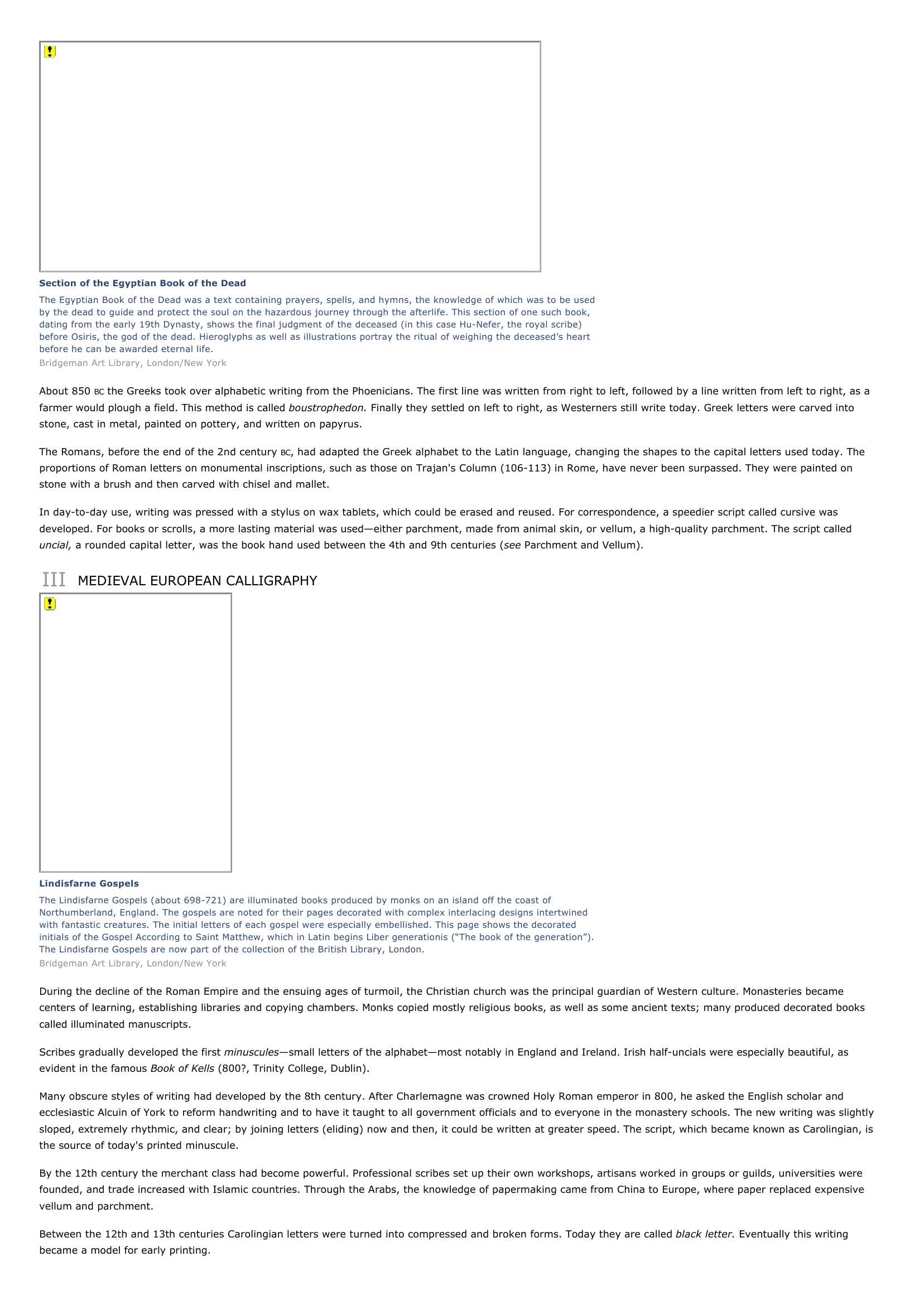Calligraphy I INTRODUCTION Japanese Calligraphy This hanging scroll is an example of Japanese calligraphy.
Publié le 12/05/2013

Extrait du document
«
Section of the Egyptian Book of the DeadThe Egyptian Book of the Dead was a text containing prayers, spells, and hymns, the knowledge of which was to be usedby the dead to guide and protect the soul on the hazardous journey through the afterlife.
This section of one such book,dating from the early 19th Dynasty, shows the final judgment of the deceased (in this case Hu-Nefer, the royal scribe)before Osiris, the god of the dead.
Hieroglyphs as well as illustrations portray the ritual of weighing the deceased’s heartbefore he can be awarded eternal life.Bridgeman Art Library, London/New York
About 850 BC the Greeks took over alphabetic writing from the Phoenicians.
The first line was written from right to left, followed by a line written from left to right, as a farmer would plough a field.
This method is called boustrophedon. Finally they settled on left to right, as Westerners still write today.
Greek letters were carved into stone, cast in metal, painted on pottery, and written on papyrus.
The Romans, before the end of the 2nd century BC, had adapted the Greek alphabet to the Latin language, changing the shapes to the capital letters used today.
The proportions of Roman letters on monumental inscriptions, such as those on Trajan's Column (106-113) in Rome, have never been surpassed.
They were painted onstone with a brush and then carved with chisel and mallet.
In day-to-day use, writing was pressed with a stylus on wax tablets, which could be erased and reused.
For correspondence, a speedier script called cursive wasdeveloped.
For books or scrolls, a more lasting material was used—either parchment, made from animal skin, or vellum, a high-quality parchment.
The script calleduncial, a rounded capital letter, was the book hand used between the 4th and 9th centuries ( see Parchment and Vellum).
III MEDIEVAL EUROPEAN CALLIGRAPHY
Lindisfarne GospelsThe Lindisfarne Gospels (about 698-721) are illuminated books produced by monks on an island off the coast ofNorthumberland, England.
The gospels are noted for their pages decorated with complex interlacing designs intertwinedwith fantastic creatures.
The initial letters of each gospel were especially embellished.
This page shows the decoratedinitials of the Gospel According to Saint Matthew, which in Latin begins Liber generationis (“The book of the generation”).The Lindisfarne Gospels are now part of the collection of the British Library, London.Bridgeman Art Library, London/New York
During the decline of the Roman Empire and the ensuing ages of turmoil, the Christian church was the principal guardian of Western culture.
Monasteries becamecenters of learning, establishing libraries and copying chambers.
Monks copied mostly religious books, as well as some ancient texts; many produced decorated bookscalled illuminated manuscripts.
Scribes gradually developed the first minuscules —small letters of the alphabet—most notably in England and Ireland.
Irish half-uncials were especially beautiful, as evident in the famous Book of Kells (800?, Trinity College, Dublin).
Many obscure styles of writing had developed by the 8th century.
After Charlemagne was crowned Holy Roman emperor in 800, he asked the English scholar andecclesiastic Alcuin of York to reform handwriting and to have it taught to all government officials and to everyone in the monastery schools.
The new writing was slightlysloped, extremely rhythmic, and clear; by joining letters (eliding) now and then, it could be written at greater speed.
The script, which became known as Carolingian, isthe source of today's printed minuscule.
By the 12th century the merchant class had become powerful.
Professional scribes set up their own workshops, artisans worked in groups or guilds, universities werefounded, and trade increased with Islamic countries.
Through the Arabs, the knowledge of papermaking came from China to Europe, where paper replaced expensivevellum and parchment.
Between the 12th and 13th centuries Carolingian letters were turned into compressed and broken forms.
Today they are called black letter. Eventually this writing became a model for early printing..
»
↓↓↓ APERÇU DU DOCUMENT ↓↓↓
Liens utiles
- Byzantine Art and Architecture I INTRODUCTION Archangel Michael This depiction of the archangel Michael, in Saint Mark's Cathedral in Venice, Italy, is an example of ancient enamel art.
- Japanese Music I INTRODUCTION Shamisen Performance The shamisen is a Japanese instrument with three strings.
- Art Nouveau I INTRODUCTION Detail of Art Nouveau Decoration This detail of a door decoration from a building constructed in the early 20th century in Milan, Italy, illustrates the stylistic themes associated with art nouveau.
- Folk Art I INTRODUCTION Carved Native American Figure This figure of a Native American trapper was carved from a single pine log (about 1850-1890).
- Indian Art and Architecture I INTRODUCTION Art on the Indian Subcontinent This map highlights places in India and Pakistan where prominent examples of Indian art and architecture have been produced.









